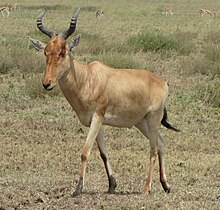Coke's hartebeest
This article may need to be rewritten to comply with Wikipedia's quality standards. (March 2022) |
| Coke's hartebeest | |
|---|---|

| |
| At the Ngorongoro Crater, Tanzania | |
| Scientific classification | |
| Domain: | Eukaryota |
| Kingdom: | Animalia |
| Phylum: | Chordata |
| Class: | Mammalia |
| Order: | Artiodactyla |
| Family: | Bovidae |
| Subfamily: | Alcelaphinae |
| Genus: | Alcelaphus |
| Species: | |
| Subspecies: | A. b. cokii
|
| Trinomial name | |
| Alcelaphus buselaphus cokii | |

| |
| The range | |

Coke's hartebeest (Alcelaphus buselaphus cokii) or Kongoni is a large migratory antelope that is native to Kenya and Tanzania.
It can breed with Lelwel hartebeest to produce a hybrid known as the Kenya Highland hartebeest (Alcelaphus buselaphus lelwel x cokii).
Appearance
[edit]The Coke's hartebeest has a long and narrow face with pointed ears. It has long legs, a sloping back, and ridged horns that are found in both males and females. It has short reddish-brown fur, a white rump, and a short tail with a blackish tuft at the end. Calves have a paler appearance.
Male Kongonis may measure anywhere from 117–124 cm (46-48 inches) and weigh about 129–171 kg (284-376 lbs), while female Kongonis are slightly smaller with a height of 112 cm (44 inches) and weigh around 116–148 kg (255-326 lbs). The horns may be up to 70 cm long.
Behavior
[edit]Herding Behavior
[edit]The Coke's hartebeest herds represent mostly female hierarchies with a typical number of 6-30 individuals. They are semi-closed to outsiders. These herds are largely migratory. Territorial bulls usually remain separate from the females except when they're actively herding or courting.
Females can sometimes stay indefinitely on a single territory as harems. Male-only herds can be up to 35 individuals.
Parent & Offspring Behavior
[edit]Pregnant females often isolate, only accompanied by one or sometimes more previous offspring. Newly birthed calves take about 30 minutes to steadily stand. Within 10 minutes, calves can walk and run. The hiding and isolation phase of females and new calves lasts for 2 weeks. Female Coke's hartebeest calve every 9–10 months, too early for the last calf to become independent.
Male calves accompany their mothers for up to 2 years, a year longer than other alcelaphines, although they mature at the same age as wildebeests, at 3–4 years. Male calves may simply run away from the original herd or be chased away by the dominant bull at 3 years, when they join bachelor herds. Between 3–4 years, males may leave the bachelor herds and begin searching for their own territories.
Adaptations to the desert environment
[edit]The hot and dry environment of the Coke’s hartebeest has led to the development of several thermoregulatory adaptations. This species uses panting as a means of evaporative cooling that responds to skin temperature rather than core body temperature.[3] Cutaneous water loss is limited through maintenance of a lower basal metabolic rate,[3] which also aids in hartebeest water economy. Most desert animals maintain a lower metabolic rate in keeping with the low nutrient availability within their environments. For hartebeest, the metabolic response during the fasted state (when food has been digested and stored) leads to adaptations that aid in protein conservation. Furthermore, they have a low water turnover amount of 9-17 liters/kg per day, in comparison to other bovines of similar size, such as the eland, which has a turnover rate of 12.7 liters/kg per day.[4] This helps the Coke’s hartebeest limit its water expenditure in hot and arid habitats.
References
[edit]- ^ IUCN SSC Antelope Specialist Group (2017). "Alcelaphus buselaphus ssp. cokii". IUCN Red List of Threatened Species. 2017: e.T815A50181521. doi:10.2305/IUCN.UK.2017-2.RLTS.T815A50181521.en. Retrieved 12 November 2021. Database entry includes a brief justification of why this species is of least concern.
- ^ Alcelaphus buselaphus cokii, Mammal Species of the World. Third edition.
- ^ a b Finch, VA (1972-06-01). "Thermoregulation and heat balance of the East African eland and hartebeest". American Journal of Physiology. Legacy Content. 222 (6): 1374–1379. doi:10.1152/ajplegacy.1972.222.6.1374. ISSN 0002-9513.
- ^ Price, M. R. Stanley (1978). "The Nutritional Ecology of Coke's Hartebeest (Alcelaphus buselaphus cokei) in Kenya". Journal of Applied Ecology. 15 (1): 33–49. doi:10.2307/2402919. ISSN 0021-8901.
- Finch, Virginia A. "Thermoregulation and heat balance of the East African eland and hartebeest." American Journal of Physiology. Legacy Content 222.6 (1972): 1374-1379.
- M. R. Stanley Price. “The Nutritional Ecology of Coke’s Hartebeest (Alcelaphus Buselaphus Cokei) in Kenya.” Journal of Applied Ecology, vol. 15, no. 1, 1978, pp. 33–49. JSTOR, doi:10.2307/2402919. Accessed 21 Sep. 2022

